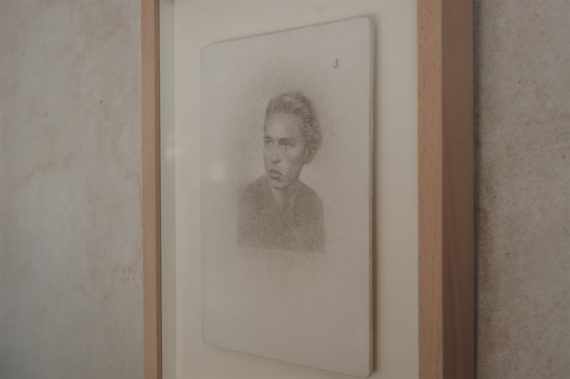Here’s a picture of a couple of recent drawings. They are done in metalpoint and they are about the size of small postcards. They’re part of an ongoing project to do with postcards that have something to do with Margate.
These particular drawings are of two of thirty-six people pictured in a small postcard of a group of people in fancy dress. I can hazard a guess that the picture was taken in the 1930s (based on some of the details captured in the photograph) and the people in the picture might be celebrating ‘Empire Day’ (‘Britannia’ sits in its centre) or perhaps it’s a carnival group or maybe even something to do with a coronation event. The choices the people have made about their fancy dress are interesting ones (I’ll write more about this if this work develops any further).
My currant hope (I use the word ‘hope’ rather than ‘plan’) is to make drawings based on other postcard images from about the same period and to place the works in company with each so as to invite the viewers to make their own connections.
I’ve posted this image of this unfinished work here as a way to make myself stick with the work. Most of my projects come to nothing either because I lose faith with my ideas or because I can’t afford to make the work (I make metalpoint drawings which are fragile and therefore have to be framed and frames are expensive). We’ll see if anything comes of this.
I’ll post things on my facebook page (https://www.facebook.com/Roy-Eastland-1495390357351370/?ref=hl) and on my wordress blog (www.royeastland.wordpress.com) as and when things develop.
As I sit here suffering with a heavy cold I thought I’d share some sketchbook drawings and make a few comments about drawing. I hope I’ll feel normal again in time for teaching Life Drawing on Wednesday morning. I’m full of cold right now and so I can’t tell if what I’ve written makes sense to anyone else but me. Oh well, that’s my excuse and here goes.
Here are a few recent sketchbook drawings of people. They are drawings of people and that’s all they are. They are drawings done for drawing’s sake (drawing as a way of thinking about drawing). They are drawings of people who were still (or fairly still) for maybe ten or twenty minutes. They are drawings of people but drawings of people are never just hand-made pictures of people. Drawings trace moments in time. Hand-drawn lines take time and the moment of their making is subtly replayed each time someone spends time to notice them. There are heavy lines, sharp lines, long lines, feathery lines… the variety is endless and each of them implies the presence of a thought. We change our minds as we draw and our lines capture those moments of change. We look and we notice something and we try to track the gist of it on the paper. The time taken to draw even the shortest line is there to see in its entirety all at once (like seeing a tiny life-span played out on the page). We pay attention to the simple presence of things whenever we draw. The drawing is always wrong. We look again and we make another line. Each time it is wrong in a different way but sometimes the mark is good in spite of its wrongness. Sometimes the line feels true or it does something interesting (something we couldn’t have predicted but which is more interesting than anything we could have predicted). It’s enough that just a small part of a drawing is interesting for it to feel good. As we make our mark we are bringing into play all our momentary perceptions, all our skill and memories of all the other drawings we have ever seen. Eventually the time is up and the pose ends and all that remains of the moment, and of the protagonists, is the drawing. One day the drawing will be the only thing left of that moment. Perhaps we make ghosts when we draw.
I don’t get to draw people as much as I’d like to. These drawings were done quickly in Life Drawing groups of at odd moments while teaching Life Drawing (in Margate and Canterbury). I have about a hundred and sixty filled-up sketchbooks to date (filled up with drawings like these ones) and the drawings will remain in those books and one day, if they survive longer than I do, they will be in the hands of someone else. I wonder what will become of them.





